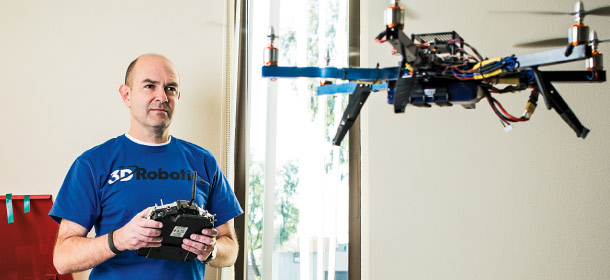Here’s the welcome post by Chris Anderson that announces the birth of the Dronecode Foundation, in partnership with the Linux Foundation.

####################################################
Welcome to the Dronecode Project
I’m thrilled to announce our partnership with the Linux Foundation to create the new Dronecode Foundation, a non-profit organization that brings together the leading open source UAV software projects under the professional management and leadership of one of the world’s foremost open innovation organizations.
For me personally, this is the culmination of a half-lifetime of work on open innovation and in particular a seven-year journey in drones that started with my children and me experimenting with Lego Mindstorms robotics parts and RC airplanes back in early 2007 (I love that first video we shot, shaky as it was; it was a life-changing moment).
I was amazed by what was possible with sensors, embedded microprocessors and GPS, but knew nothing about drones. So I set up a community called DIY Drones, mostly to “ask dumb questions in public”. Two wonderful things happened as a result. First, lots of people generously answered my dumb questions and helped me learn about all the disciplines that come together in aerial robotics, from software and electronics to aerodynamics and data analysis. Second, the existence of this community created a place for other people to ask their own questions, and in those early days of amateur UAVs, everyone was learning as we went. Even the experts in one domain had to learn about the others that had to come together to take robots into the air.
The DIY Drones site quickly grew, and is now one of the largest robotics communities in the world (nearly 60,000 active members and as much as 2 million page views per month). But it wasn’t just talk: members were collaborating on electronics, software and aircraft designs, first informally and then increasingly in organized open source projects, including the APM/ArduPilot platform (including ArduCopter, ArduPlane, ArduRover), Mission Planner, DroidPlanner and countless others, from radio/telemetry to video. Many of these stood on the shoulders of other open source innovation projects, especially the Arduino open computing platform, which gave many of these projects the “Ardu” prefix.
At the same time, leaders in the academic robotics world were also embracing open innovation, and we soon found a kindred spirit in Lorenz Meier from ETH in Zurich, one of the best robotics research institutions, and the PX4 and MAVlink projects that he leads. Soon we joined forces, and today the Pixhawk autopilot platform represents the fruits of that collaboration, a joint effort of an open source community, a premier academic institution and a Silicon Valley company (3D Robotics, which I co-founded in 2009 with Jordi Munoz, who I met through DIY Drones.)
Today, I’m proud that this platform has been adopted by more than 100,000 users and is helping bring advanced UAV technology to regular people, allowing them to do extraordinary things from Hollywood-quality aerial video to crop-mapping, 3D-scanning of buildings. It’s a classic example of the power of democratizing a technology; we are entering the consumer and commercial drone age and I’m delighted that an open source platform is helping lead the way.
Now that we have reached this level of adoption and maturity, it’s time to adopt the best practices of other highly successful open source projects, including professional management and governance structures, to ensure the continued growth and independence of these efforts. There is no better organization to lead this than the Linux Foundation. Not just because of the extraordinary success of Linux itself, but also because of all the other collaborative projects that it helps run, allowing each to reach the next level of participation, performance and innovation. The combination of independence and a clear path for corporate participation and adoption while protecting open source ideals is something these projects have always been built on, and the experience and reputation of the Linux Foundation ensures that those values will be embraced and preserved in our own projects as the industry around them grows.
The creation of a formal non-profit organization to organize, lead and coordinate these projects also makes it easier for companies who want to embrace open innovation in their own UAV and robotics efforts. This allows them to participate in a more formal way that helps ensure that they can contribute back to the community, in everything from code to people power to financial resources. So I’m particularly delighted to welcome our company launch partners, including such giants as Intel, Qualcomm, Box and Baidu in addition to UAV leaders such as Yuneec, Walkera and my own 3D Robotics.
Why now? Not just because drones are hot and open innovation is hotter 😉 Most of all, it’s because as our platforms have matured, they are increasingly heading in the same direction as Linux itself. The extraordinary improvements in mobile hardware technology (thanks Intel and Qualcomm!) and cloud technology (thanks Box and Baidu!), means that our community and software is increasingly running on gigahertz-class Linux computers and with constant broadband connections to the cloud. That means that the opportunity for us to join forces with the broader Linux and Embedded Linux communities is now, and the Linux Foundation is the perfect place to lead that convergence.
Welcome to Dronecode. I can’t wait to see what this community creates next.
By Chris Anderson, CEO 3D Robotics
Souce: Dronecode.org

Sounds great. The Dronecode foundation definitely will do good to the development of FPV community. Last month, when Chris came to China and delivered a speech, he said 3DR would be an Android system.